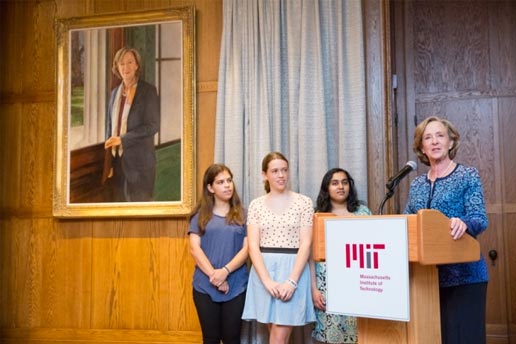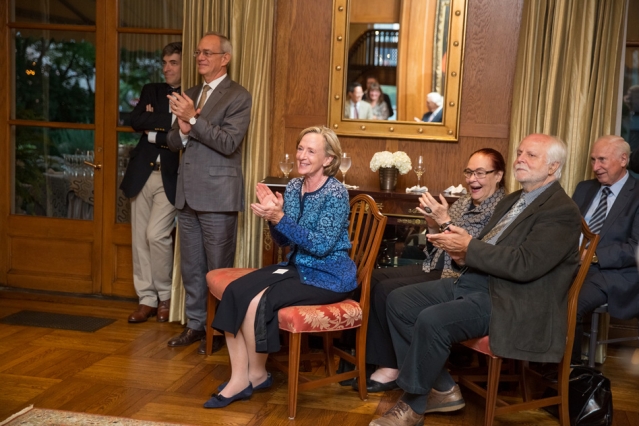
Members of the MIT community gathered Friday evening at Gray House to celebrate President Emerita Susan Hockfield, who led the Institute from 2004 to 2012. The evening culminated in the unveiling of a presidential portrait of Hockfield, painted by Steven Polson.
President L. Rafael Reif greeted the audience, explaining how Hockfield’s presidency played a “transformative role” in the history of the Institute. “Susan changed [MIT] forever,” he said, “and our gratitude will endure forever.”
Reif provided a brief overview of Hockfield’s legacy as president, highlighting her focus on creating cross-disciplinary collaboration in cancer research (with the founding of the Koch Institute for Integrative Cancer Research) and clean energy (with the founding of the MIT Energy Initiative, or MITEI). “She provided exceptional leadership for MIT in many other areas, from advanced manufacturing to MIT150, from diversity to digital learning, and from Kendall Square to our global engagements,” Reif noted.
Reif, who had been selected by Hockfield to serve as provost, called her a “master of the art of leadership,” in both obvious and less obvious ways.
“Through her years as president,” Reif said, “the world saw Susan’s visible qualities as a leader: her brilliance; her unlimited capacity for hard work; her gift for seeing a subject from many angles; her ability to deliver calm, clarity, and confidence; and her personal standards of dedication and excellence, which challenged all of us to be the best that we could be.”
Reif added that his own time as president had given him a heightened appreciation for the “invisible work” of Hockfield’s leadership, her “ability to achieve exciting, important, difficult progress by persuading and leading exciting, important, and,” he said with a twinkle, “sometimes difficult people.”
Following Reif’s remarks, three MIT faculty members shared their views on Hockfield’s presidential legacy. Paula Hammond, the David H. Koch Professor of Engineering and head of the Department of Chemical Engineering, described the tremendous energy she feels working at the Koch Institute.

Hockfield with President L. Rafael Reif (standing, to her right) at the portrait’s unveiling. Photo: Bryce Vickmark
“Every day I walk into the [Koch Institute] building, I feel the energy of the place inside, the connections that are made,” Hammond said. “I’ve learned incredible amounts about biology from my colleagues; my colleagues have learned incredible amounts from us engineers. We’ve learned how to put those things together with clinicians to do something that can save lives.”
Yet-Ming Chiang, the Kyocera Professor of Ceramics in the Department of Materials Science and Engineering, cited Hockfield’s approach to creating MITEI: “The way [Susan] did it was by being inclusive,” Chiang said — noting that she had even consulted colleagues at other institutions.
The final faculty speaker, Institute Professor Phillip Sharp, cited Hockfield’s collaborative legacy as exemplified by the Ragon Institute and the Broad Institute, as well as the amazing growth of Kendall Square as a global biotechnology center.
Several of Hockfield’s student advisees unveiled Polson’s portrait of her. Prior to painting Hockfield, the New York-based artist had painted official portraits for the State Department of three former Secretaries of State: Colin Powell, Madeleine Albright, and Condoleezza Rice.
“Susan herself was what was so different about painting this portrait,” Polson told MIT News. “She brought a scientist’s perspective to the studio, and showed great interest in all parts of the process.”
When Hockfield took to the podium, she turned the focus away from herself and back to MIT’s long history of achievement and its vibrant community. When she lived among the presidential portraits at Gray House, Hockfield noted, “I would sometimes look at these giants, and feel very much like I was standing on their shoulders and feel confident that my feet were on a strong foundation. I only hoped that I could lay a foundation stone as incredible.”
After describing her wish that the eyes of her just-unveiled portrait could reflect the MIT community she now watched in front of her, Hockfield concluded, “It’s a remarkable community to be a part of, and it’s remarkable to reflect your ambitions, your desires, your dreams, and actually see them come true.”